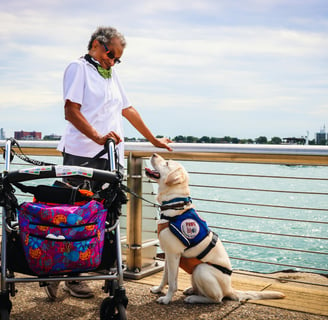Handling Public Interactions with Your Service Dog
Learn effective strategies for setting boundaries, educating others, and responding to common questions when out in public with your service dog. Gain confidence in navigating public spaces with your furry companion.
LITTLE LESSONS
Crysta Germany
7/6/20243 min read


Starting Off on the Right Paw:
If you have a service dog, you've likely had some interesting interactions with the public while you were out. It's something all handlers experience, and there are always a few stories to tell. However, there are some quick ways to handle these public interactions, both positive and negative.
Educating the Public:
Be Prepared to Educate: The majority of the general public doesn't know much about service dogs and the work they do. You will undoubtedly encounter many questions, and it is good to help educate others. You'll likely be asked things like:
Why can't I pet your dog?
Isn't that just your pet?
What does a service dog even do?
Use Simple, Clear Language: The easiest way to convey information is to keep it short and sweet. Brief answers, such as "My dog is working right now and can't be distracted," are often sufficient. While you are in no way required or expected to, many service dog handlers prefer to carry information cards to hand out when they meet a curious individual or have to deal with misconceptions. You can find many customizable ones on Etsy.
Dealing With Unwanted Attention:
Stay Calm and Polite: When people approach, it is important to remain calm and polite, to help facilitate a good conversation or to help end an aggressive one. Here are some common things to say:
"Thank you for your interest, but my dog is working right now and needs to stay focused."
"I appreciate your curiosity, but it is important to not distract service dogs while they work."
Set Boundaries: You are entitled to your privacy. You do not need to answer any invasive questions or entertain any interactions you don't want. Clear boundaries are important, and these are a few basic ones to help you set those:
"Please do not pet my dog, they are working."
"I do not wish to discuss my disability with you."
Handling Questions and Comments:
Common Questions: While there are many questions asked about service dogs, some are more common than others. Here's a few and some good ideas for responses:
"Can I pet your dog?" - "No, they are working, it's important not to distract them."
"What does your dog do for you?" - "They assist me with tasks related to my disability."
Responding to Misconceptions: Just as with questions, there are many misconceptions about service dogs. Clarifying these can make the future better for service dogs and their handlers. One of the most common misconceptions is that service dogs are just glorified pets. It's important to clarify that they have real jobs that assist their handler.
Dealing with Negative Interactions:
Stay Composed: Although it can be hard, it is in your best interests to remain level-headed during negative interactions. Avoiding defensiveness will generally help keep the conversation productive.
Know Your Rights: Understanding your legal rights in various situations can help you continue your activities without undue interruption. Check out our other post, which delves into federal guidelines, for more detailed information.
Training Your Service Dog for Public Interactions:
Desensitization Training: Desensitizing your service dog is a good way to help eliminate external distractions. If they learn to ignore things such as random people calling them and treats, it will make it easier to end the interaction. It's good to practice and a variety of environments in order to desensitize your dog appropriately. Just be sure that you don't push your dog past their limits, as that can severely hurt them.
Reinforce Commands: Reinforcing your dog's commands is also a good way to manage and mitigate public interactions. Ensuring that they know their commands and will listen to them ensures that their focus will return to you, despite most interactions.
Conclusion:
While a lot of public interactions can be negative, many are positive, and even more are simply neutral. We can't stop negative interactions entirely, but we can minimize them by educating the public about service dogs. The more people understand, the smoother our experiences will be.
photo Credits: provisionshots on pexels
